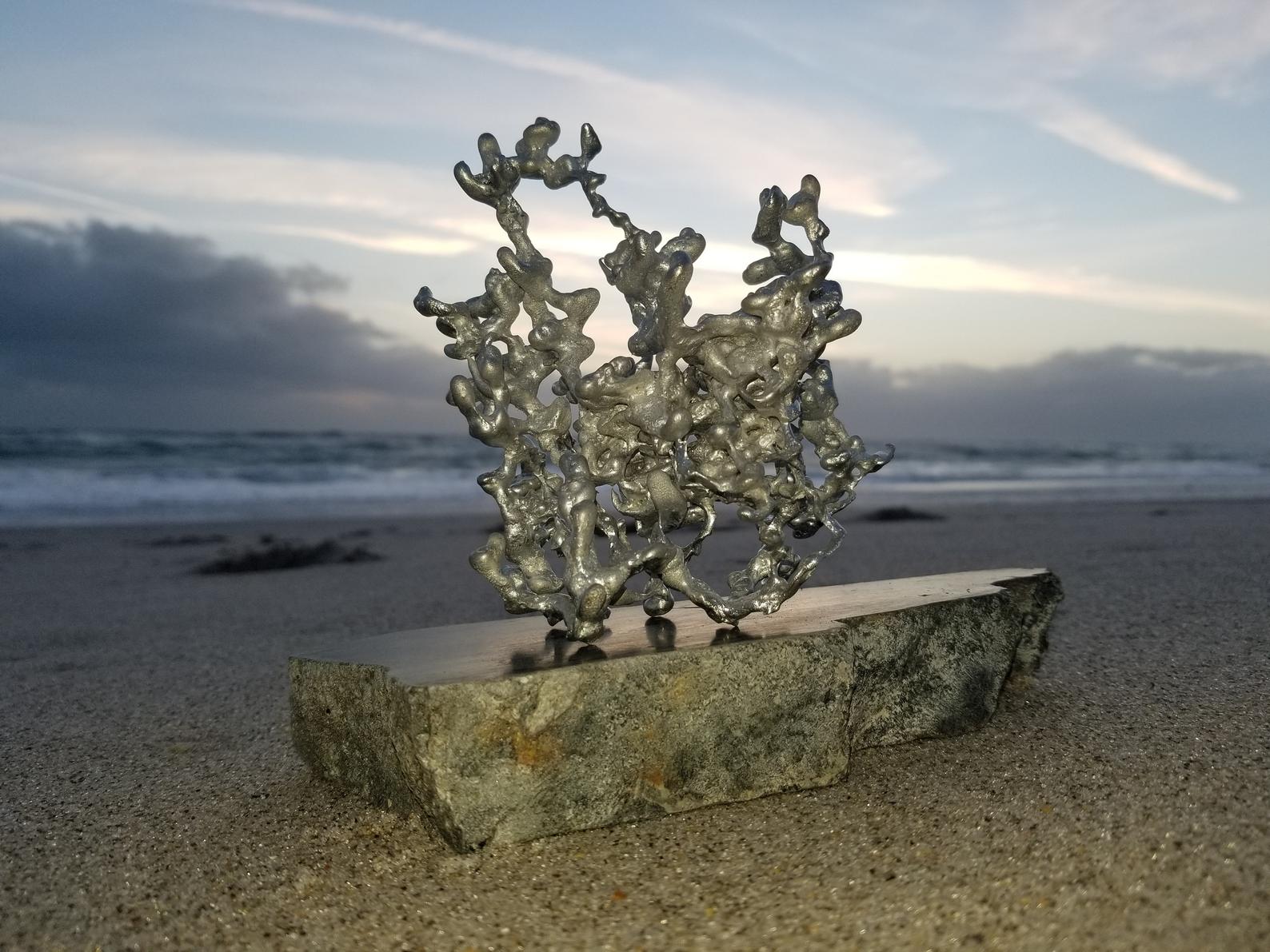
OMG
Art and Nature Combined With Ant Nests

Art comes in amazing, weird forms. For many of us on the consumer side aluminum is most familiar in the form of soda and beer cans. It’s a soft, durable metal that can be shaped in lots of different forms. Most importantly, aluminum has a low melting point and cools at a medium rate, making it produce some very interesting forms of metal cooling when accidentally left to its own devices and gravity. The metal as a liquid can flow into lots of different shapes and forms, making it a very easy medium to work with in molds. No surprise, aluminum is one of the most common metals used in casting products, including food containers and transport, engine cases and aircraft parts. However, few ever expected to ever see aluminum and ant nests put together to create an amazing new style of artwork.
What in the World?

Artists have to naturally be a creative bunch, but some of the savviest of the art world are those folks who realize that nature is pretty good at amazing designs as well. That was the case when a fellow named David Gatlin realized that he could combine ant nests and aluminum to produce really intricate, amazing artwork that was probably impossible to replicate by hand.
People Really Don’t Like Fire Ants
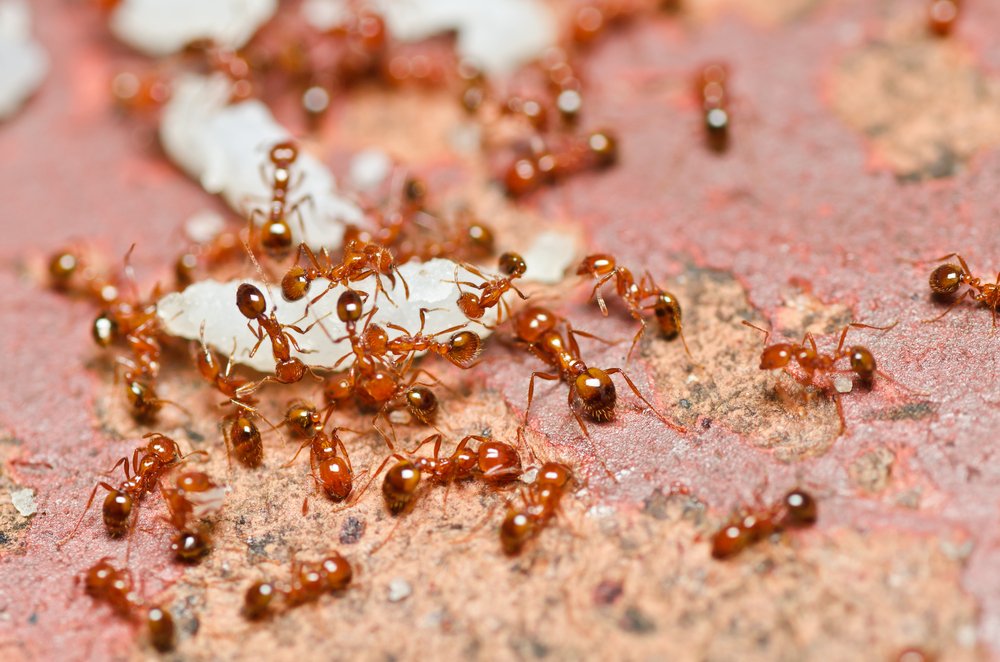
As an invasive species, fire ants are extremely nasty and persistent at propagating. The species has run across the Southwest and easily stretches its invasion from Texas to California. The bites from these ants are painful and some folks have even been put into the hospital by the little critters. Part of the issue is how they swarm an enemy, even humans.
Fire Ants Are Not Local
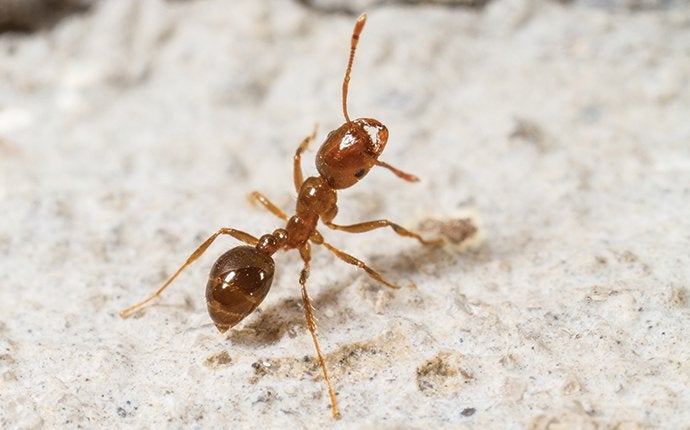
Fire ants are indigenous to the Mato Gross area of Brazil and definitely not a native species in the U.S. They are dubbed an “invasive” insect and targeted for eradication by U.S. pest control and agricultural agencies at every level of government. Fire ants first showed up in force in the U.S. as far back as the 1940s, however, likely imported accidentally into Mobile, Alabama. Today, fire ants can be found in at least 13 specific states across the U.S., and the number is growing.
Nature’s Experts at Surviving
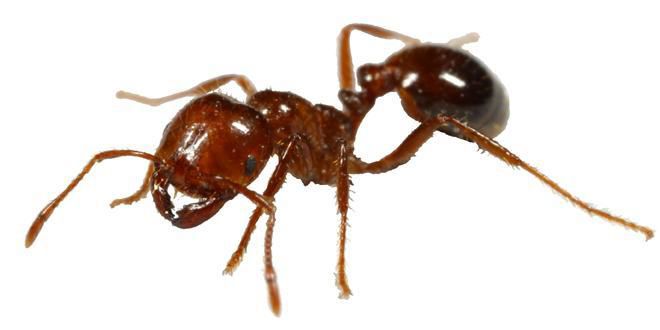
As insects, the red fire ant is notoriously aggressive as well as being a predator. Where many other ant types find ways to live with their ecosystem and even use other insects and bugs to generate food for the colony, fire ants kill everything in their path. They are also very ingenous at solving natural barriers. Fire ants have been seen using floating logs to cross rivers that would otherwise block them completely.
Infestations Move Fast

Fire ants seem to have the ability to travel quickly, much of it due to catching a ride on farm harvest material and soil moved from one destination to another. Once a fire ant colony gets established, as it did in Oklahoma in 1985, it can pop up in the surround regional area within months. From the panhandle state the fire ants moved systematically and aggressively, reaching all over Oklahoma state in total by 2007. Again, the primary modes of transport tended to be nursery products (potted plants) and grass turf for new homes.
Rural Areas are Hit Harder

The colonies of invasive fire ants seem to thrive better in rural areas versus suburban or urban areas. They can frequently grow undisturbed in country and open location, knocking out competing ants and bugs and even small wildlife. Fire ants are notoriously aggressive, swarm quickly, and their bites are horribly painful when in multiple form.
Amazing Workers by the Thousands

Fire ants are extremely industrious, constantly working night and day in producing a larger and larger complex. Every ant works moving dirt from inside to the surface, creating all the cavities used for tunnels and storage as well as safety from above. Fire ants tend to prefer dry soil as well as sandy locations, and clay tends to be used as well. A solid ant nest can reach a foot in depth as well as the same size across easily, and that’s a small nest.
Easy to Miss and Step in Them
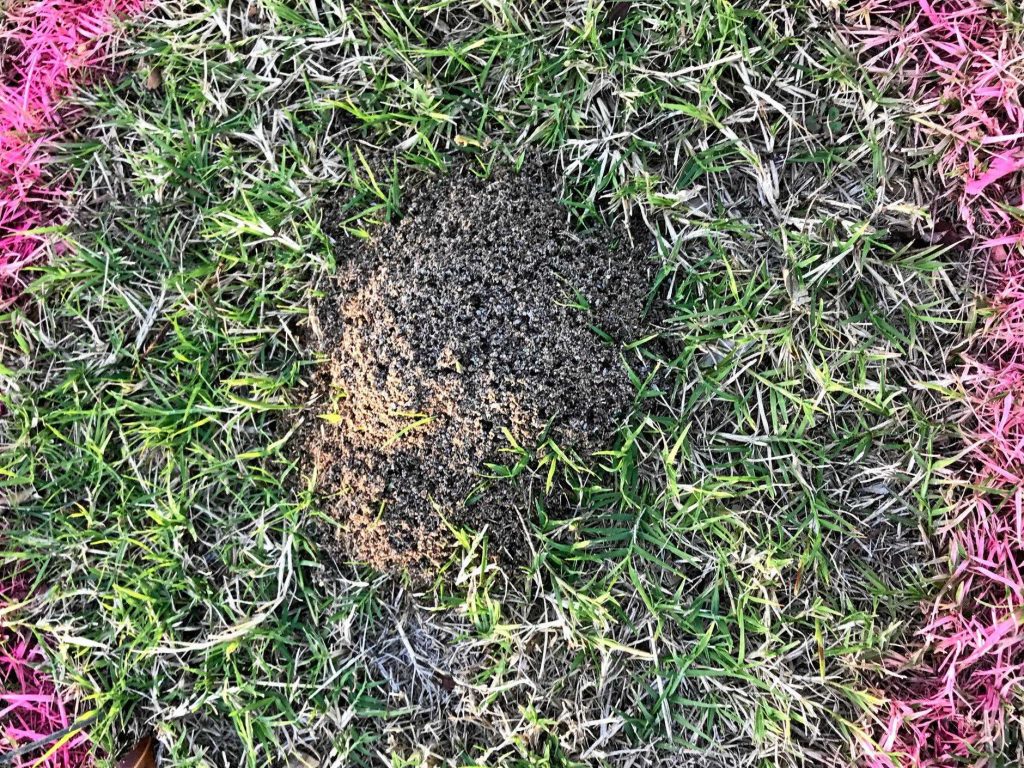
Unlike other hands, fire ant colonies tend to work with their environment. They will frequently leave the vegetation that already exists alone and not damage it. That makes fire ant nests easy to miss and worse, easy to step on. And once a nest is stepped on, all hell breaks loose. Thousands of ants will come running out in an instant, giving off pheromones of defense and attacking anything living in range, including humans.
Extensive Nest Range

The nests built by the fire ants can be amazingly big too. While the core nest will be a ball of networks one to two feet in size all around, the foraging tunnels can be far bigger. Fire ants have been known to have foraging connections as long as 200 to 300 feet from their core network. These insect colonies will frequently be found in flat areas with lots of open range and sun. The one area fire ants aren’t fond of is heavy forested locations.
Getting Stuck is Bad Experience

One fire ant is bad enough as a sting. The bite hurts and is very noticeable as soon as it happens. Hundreds of fire ants or thousands can send a person into shock, potentially killing a grown human being unfortunate enough to be trapped in a colony’s path.
The Typical Medical Response

For those bit, the standard medical approach is usually the same as for any insect bite. The patient’s affected area needs to be cleaned and disinfected, a calming medication is applied to reduce the swelling, and the patient has to avoid scratching that could cause infection. Lots of homemade remedies exist from extensive experience.
The Government Has Fire Ants Targeted
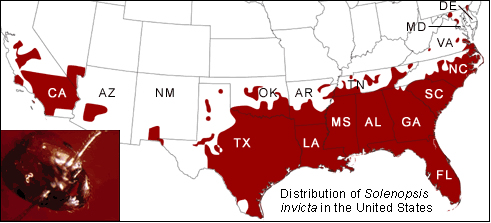
Because they are considered an invasive species, multiple state and local government work regularly at trying to eradicate fire ant nests where they are found. There is no protection of fire ants and many times they are hunted to avoid greater damage to the local ecology.
They Just Aren’t Cooperative & Make a Lot of Enemies
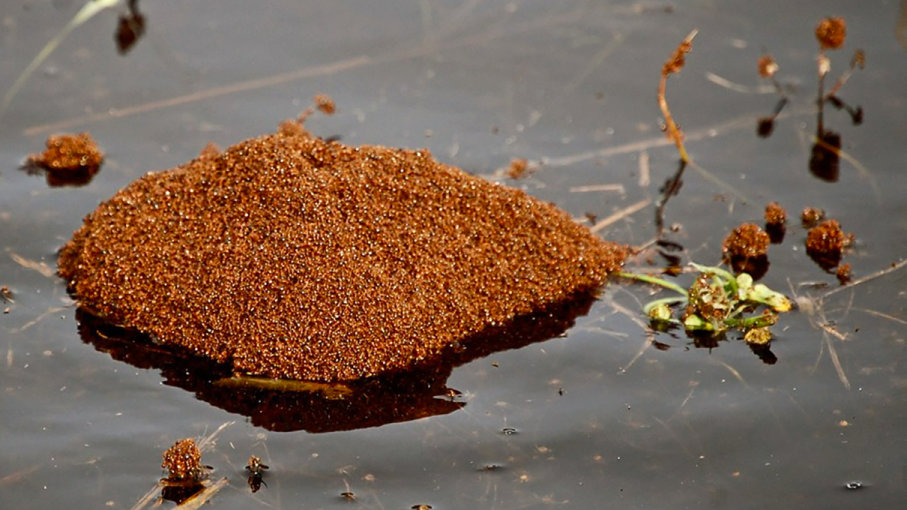
As a species, fire ants seem to be unable to cooperate with anything biologically, even when motivated to do so. In fact, they seemed to get more riled up when their environment is dramatically changed, such as during local flooding.
A Rather Effective Ant Removal

Fire ants are also incredibly hard to get rid of. They don’t respond well to basic pesticides, and both homes and nature have been run amok with their colonies. David Gatlin decided one day that he was going to produce a rather permanent kill method by pouring molten aluminum down an ant nest. The molten metal would fill every crevice and tunnel as well as kill the ants instantly.
Molten Aluminum Attributes

Aluminum begins start warping to heat at lower temperatures but it really becomes liquid at around 1,400 degrees Fahrenheit. When left to normal temperature, the metal takes a while to cool down and solidify again. That made it ideal for what Gatlin wanted, an ant death-dealing liquid that would both kill the pest as well as block its tunnels deep down.
Ant Tunnels Galore

Fire ant colonies are extensive and their tunnels match the size and number of the insects. The maze can be intricate but most views are only side cuts of the nests, missing the extensive nature of the entire nest. Being made of dried dirt, many tunnel networks fall apart with digging. However, dropping liquid metal in the same network produced an amazing result.
An Upside Down Christmas Tree
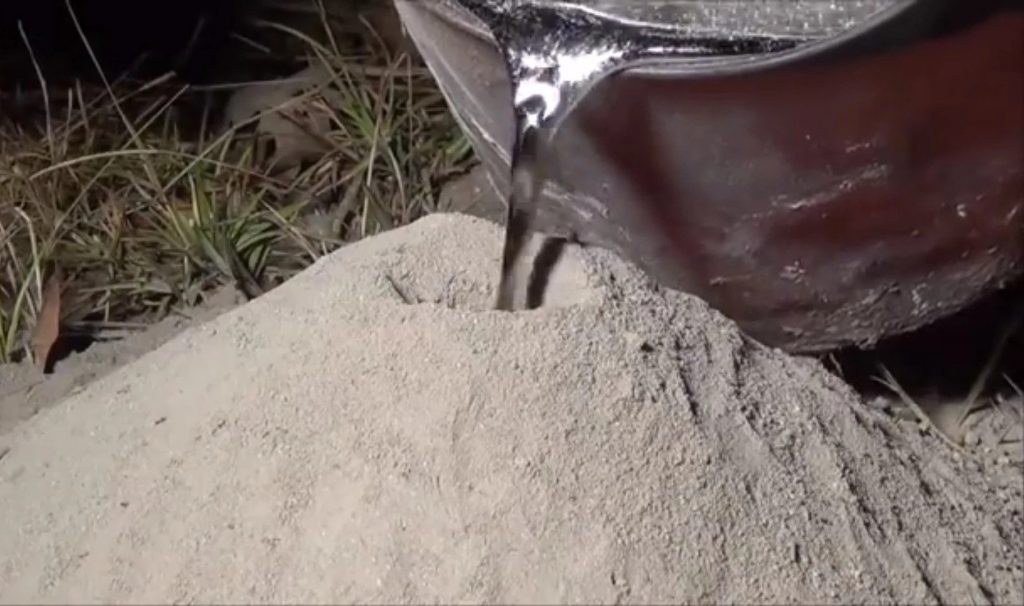
After a few nest kills Gatlin got to thinking what the dried metal might actually look like underground. Even better, the metal didn’t fall apart on touch after being dug up. It was solid. So that suddenly gave Gatlin an idea. He had an intricate piece of art on his hands that just needed to be dug up. Once freed from the earth, the sculpture was amazing.
Try, Try Again
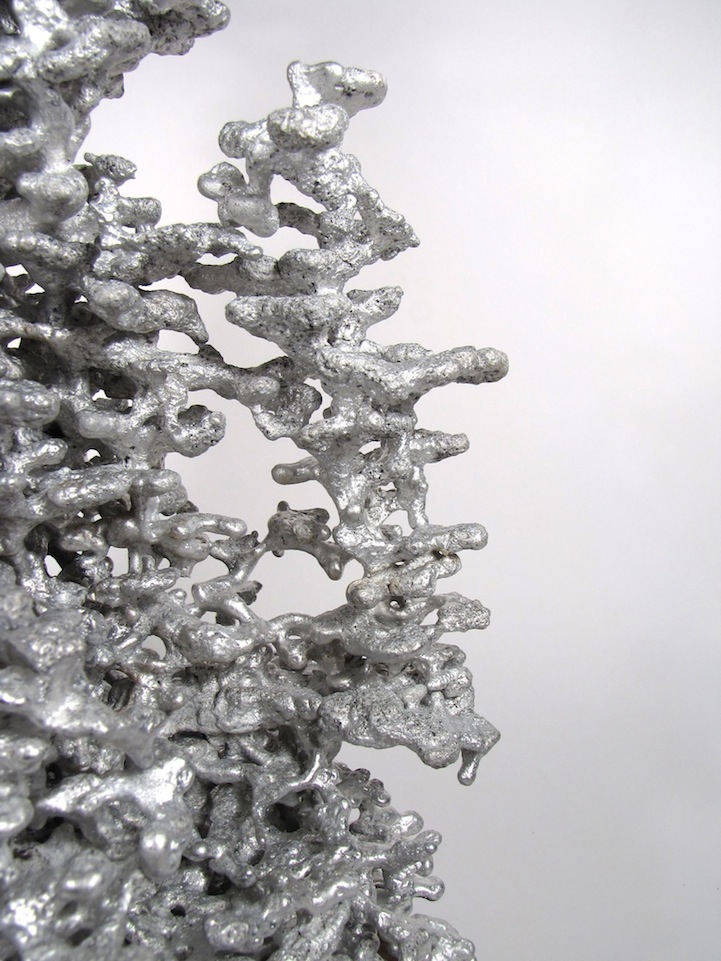
Gatlin wanted to see more. He was amazed by the result of the ant nest combined with the molten metal. So, he went looking for every ant nest available. The results were unique every time. It didn’t matter if the nest was fire ants or basic carpenter ants, they were all a different structure with an amazing network of detail and connections.
The Process

The first step is to melt aluminum hot enough that in reaches a completely molten state. With an ant nest identified, usually by its cone sticking out the ground surface, the aluminum is carefully poured into the main entrance. The metal flows down the channels immediately and is continued until every possibility is filled up.
The Side Effects
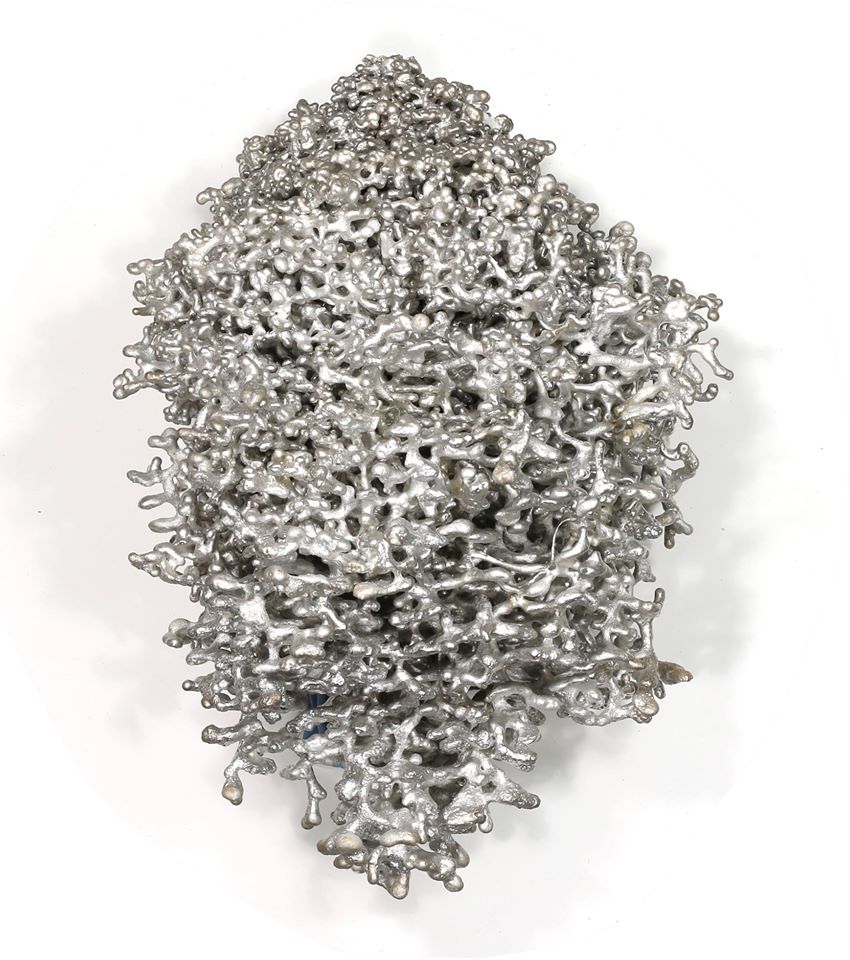
As the aluminum goes into the ant nest, the surround dirt and earth begins to get hot as well. It’s quite common as the heat is released for the top of the nest to start smoking and steaming. When the aluminum level reaches the top, the nest is filled and its time to back off pouring. The main entrance tends to collapse from the heat and pressure coming upward.
Removal
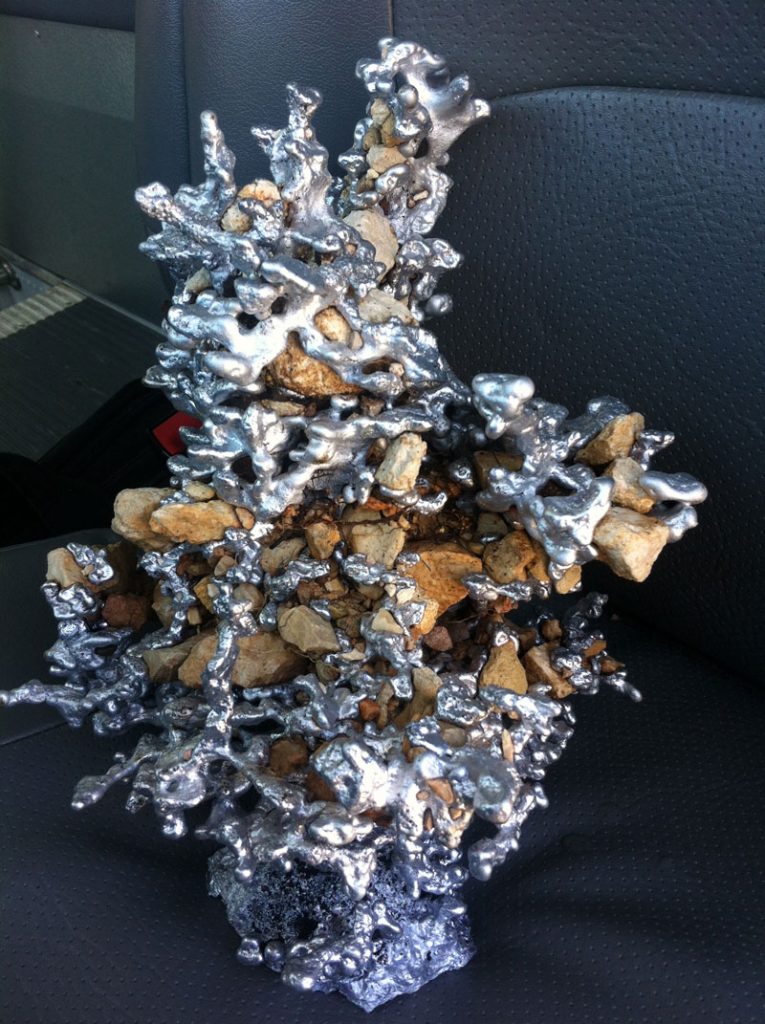
After the aluminum has been given time to cool and the heat is absorbed into the surround earth, the metal has hardened and it quite sold. The excavation phase begins. Starting with a basic garden hand shovel, the extent of the nest is identified. Many nests can easily go downward as much as 18 inches to two feet and outward in a radius as much as a foot.
Finishing and Washing

When the aluminum nest structure is completely exposed, it’s time to remove it from the ground. The weight of the entire aluminum could be as much as 20 to 25 lbs, not including the dirt clinging as well. The nest structure is then placed, transported, and brought to a hose. With spray water the dirt this time melts away and what’s left is the amazing detail of everywhere the aluminum flowed into the former ant nest.
The Final Product

Every piece of art needs a framework to display it. Gatlin takes the finished nest mold, brushes it off clean, and then mounts the network on a solid wood base with a finished stain and lacquer. The result is a piece of art that can be displayed on a table, as a coffee table decoration or put in a school lab and a museum as well. Given that aluminum mold is so light to begin with, it doesn’t fall over top-heavy with a good base attached, and people can’t stop looking at it once displayed.
Suddenly Popular

Gatlin’s ant nest artwork grew very quickly to becoming a really big hit. The combination of the shiny aluminum metal, the durability of the intricate connections and the entire chaotic design of an ant nest was visually appealing. Even more interesting, the method how the artwork was created caught people’s attention. Orders started creating demand, and Gatlin’s work became very, very popular.
The Establishment of AnthillArt
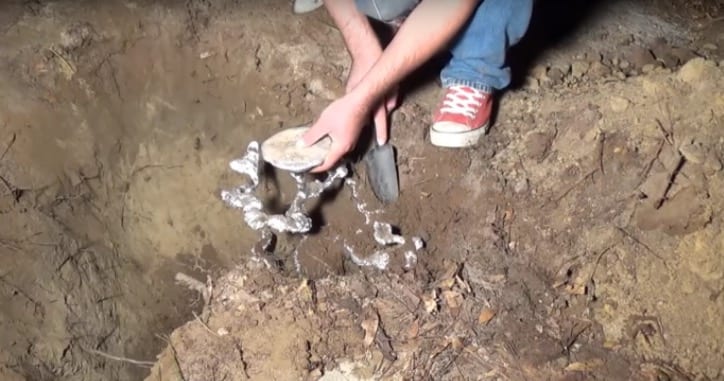
Realizing his success, Gatlin created his own business studio with AnthillArt and displayed both his finished works as well as the nature of how the pieces were created. The work became a social media explosion as the aluminum ant nets became a viral story on the Internet. Gatlin’s popularity exploded in the art world, and his works were wanted repeatedly.
Social Media Can Make a Kingdom

The footage showing how Gatlin created his works was an immediate Internet breaker. With over 15 million views watching just the YouTube video detailing the process, Gatlin can easily claim his name as one of the more popular choices on social media for entertainment. The popularity of the video also probably gave Gatlin an additional revenue stream as well via the Internet.
Finishing a Nest

After the molten aluminum has done its hot deed, the process involves a careful digging up of the entire nest, shaking off the dirt and clods, and using a brush to perform the final cleaning of the infrastructure. The hardened aluminum works like a negative print of the nest where the aluminum has filled in every void the liquid form could flow into before drying.
Customers From Different Walks of Life

Gatlin’s nests are extremely popular with lots of different groups. Schools order then to study the behavior and nest product of ants molded by the process. Art collectors love the detail and unique nature of every piece that can’t be replicated as a copy. Homeowners buy them because they want an accessory for the furniture or living room as an amazing talking piece.
Not Everyone is a Fan

While those who are amazed by visual intricacies love the AnthillArt products many in the biology and conservation side think the approach is outright belligerent and typical human abuse of nature. Critics argue that the approach is an outright attack on animals and should be stopped. Quick to rebuttal, Gatlin points how red ants are targeted for eradication anyways, and he focuses on empty nests otherwise.
Critics are Vocal

Some opponents to Gatlin’s work are extremely aggressive in their opposition. From statements that the method makes them sick to the stomach to calling Gatlin a murderer, there might very well be a growing number of critics to AnthillArt products as there are fans. In this respect, Gatlin can definitely claim to be in the company of many other artists who infuriated people and even authority types.
A Middle-Ground Opinion

Professional conservationists have weighed into on Gatlin’s art as well. Buglife, for example, reserved its opposition only if the insects were truly still present in the nest, such as in the case of fire ants. If the nest was empty, they saw no issue with Gatlin’s method of art production. In fact, they liked the idea of showcasing what ants could make with a nest design and making it permanent for everyone to see.
Aluminum as an Art Medium

Gatlin is not the first artist every to realize the beauty of aluminum. Many artists in the West, for example, have realized how amazing aluminum can be melted and cooled after wildfires, liquifying aluminum car wheels and similar and creating eye-popping flows and structures that fit in art galleries everywhere even if from tragedy.
Biology Science Studies Ant Nests Regularly

While not using aluminum per se, entomologists have been studying ant nests for years, noting they are an integrated system of construction produced by a collective effort of a colony versus individual talent or skill. Other mediums that have been used to map ant nests in part or whole have included dental plaster, wax and similar materials that liquify and then harden when cooled.
Upside Down Christmas Trees are Common
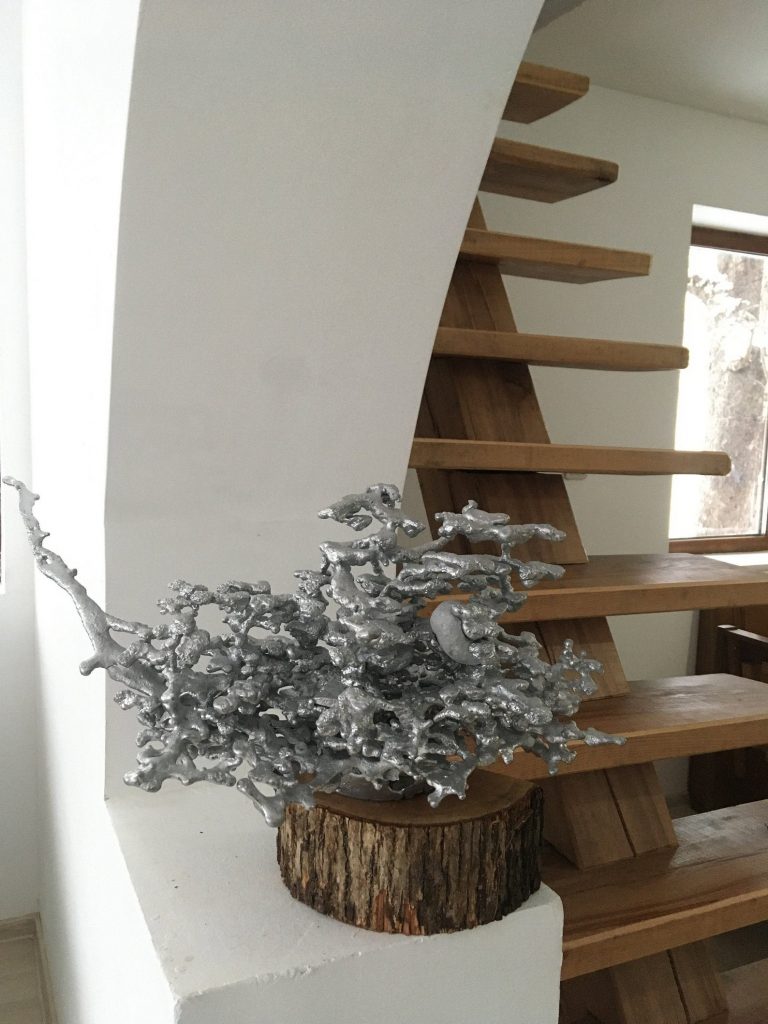
Many of the networks produced are frequently referred to as upside down Christmas trees. The entrance to the outside world tend to be one or two main tunnels but from there the network explodes tremendously and in multiple directions. Others have compared the network to an upside-down oak tree with lots of branches and leaves, looking very similar.
Nature and Art

Many artists have blended nature’s amazing ability to create beautiful designs with human ingenuity and creativeness in capturing this beauty. Some have tried to emulate nature, like a photograph capturing a moment in time. Others have drawn inspiration from nature, starting with its form as a blueprint and then working further from their with human spark and thought. Still others try to bridge nature back to humanity to form bridges and show the two can blend.
Judgment Reserved

From a purist perspective Gatlin’s work may wrong, killing life to create art. Others don’t find the lines so defining. The fact that there is debate and there continues to be attention at a process that creates an one-time, amazing form of display and creativity by some kind of life, whether human or insect, is fundamentally the root of why art is so influential. In medieval and renaissance times art was promoted and resisted. Today is not so different. We still debate its value, sometimes in arguments, sometimes in respectful debates. Art is as much about how we think as it is how we react and emulate the world around us.
OMG
Highway Adventure: Escaped Sulcata Tortoise’s Journey Halted by Arizona Rescuers

An unexpected traveler caused a stir on an Arizona interstate near Picacho when a large sulcata tortoise was discovered attempting to cross the highway. The tortoise, it was later revealed, had embarked on a remarkable journey after escaping from an ostrich ranch located approximately three miles away.
Sulcata tortoises, also known as African spurred tortoises, are native to the southern edge of the Sahara desert. These impressive reptiles are the third-largest species of tortoise in the world and the largest mainland tortoise. Known for their hardy nature and long lifespans, sulcata tortoises can live for over 70 years and reach weights of up to 200 pounds when fully grown.
The rescued tortoise’s adventure highlights the species’ surprising mobility and endurance. Despite their slow-moving reputation, sulcata tortoises are capable of covering significant distances, especially when seeking food or a mate. Their strong legs and sharp claws, evolved for digging in their native arid habitats, allow them to traverse challenging terrain – though perhaps not as safely as they might on the African plains.
Local authorities and wildlife experts were quick to respond to the unusual sight of this desert dweller on the interstate. The rescue operation not only ensured the tortoise’s safety but also prevented potential traffic hazards on the busy highway.
This incident serves as a reminder of the responsibilities that come with keeping exotic pets. Sulcata tortoises, while popular in the pet trade due to their docile nature and impressive size, require specialized care and secure enclosures to prevent escapes like this one.
The tortoise’s safe retrieval and its journey from an ostrich ranch to a major highway underscore the importance of proper animal husbandry and the unexpected challenges that can arise when managing diverse species in captivity. As the sulcata tortoise returns to more familiar surroundings, its brief highway adventure stands as a testament to the species’ resilience and the community’s quick action in wildlife preservation.
OMG
Dinner Cruise Turns Heroic: Lost Dog Rescued Miles from Florida Shore

An evening boat ride became an unexpected rescue mission when passengers and crew aboard the Sanibel Harbor Princess spotted a dog swimming alone in Florida’s waters. The canine, later identified as Ellie, was found over a mile from Fort Myers Beach on July 28, prompting a swift rescue operation.
Captain Terry Johns, a veteran of the Coast Guard, recounts the moment of discovery. Midway through the cruise, commotion erupted among guests as they noticed a small head bobbing in the water. Quick action was necessary, as Ellie was dangerously close to the boat’s rear.
With skilled maneuvering, the yacht’s crew positioned the vessel to safely retrieve Ellie. Once aboard, the exhausted but friendly dog was provided with food and water. The crew’s training proved invaluable in executing the rescue efficiently.
Post-rescue, Ellie was taken to a veterinarian for examination. Despite having a microchip, identification proved challenging due to malfunction. A crew member volunteered to care for Ellie temporarily while efforts to locate her owners continued.
The rescue story, broadcast by local news outlet WINK News, caught the attention of Ben and Kathleen Baker, Ellie’s distraught owners. The couple had lost sight of their pet during an afternoon boat outing and had spent hours searching to no avail.
Overcome with emotion, 72-year-old Ben Baker expressed his relief at seeing Ellie safe on the news. A few phone calls later, and the Bakers were reunited with their beloved pet, turning a potential tragedy into a heartwarming tale of community effort and canine resilience.
This incident highlights the importance of pet safety on boats and the impact of quick thinking and compassion in emergency situations.
OMG
Eight Puppies Rescued from Texas Heat Will Soon Be Ready for Adoption

Eight puppies left in the scorching Texas heat have been rescued and are now safe, thanks to some quick-thinking deputies and animal control officers.
The puppies were abandoned in a carrier on a field in Tarrant County, Texas, where temperatures reached over 100 degrees. The Tarrant County Sheriff’s Office shared this on their Facebook page.
A kind person found the puppies without any water and alerted the authorities. Unfortunately, since there were no cameras in the area, it’s unlikely they will find out who left the puppies behind.
Deputies Collin Stephenson and Haley Drew from the Tarrant County Sheriff’s Office, along with the Fort Worth Animal Care and Control team, rescued the puppies.
Fort Worth Animal Care and Control shared an update on Facebook, including photos of the puppies, saying, “The puppies that were rescued from a carrier in 100-degree weather by Tarrant County Sheriff’s Office are doing much better.”
The puppies, about six weeks old, are now at the Chuck & Brenda Silcox Animal Care and Adoption Center. They are believed to be shepherd mixes and have been given names after popular chip brands: Cheetos, Fritos, Ruffles, Lays Potato, Cheese Itz, Doritos, and Pringles.
Deputy Stephenson told Fort Worth Animal Care and Control that he plans to adopt one of the puppies.
The animal shelter is looking for people to foster or adopt the puppies, who should be ready for adoption next week.
Tips to Keep Your Pets Safe in the Heat
- Provide Plenty of Water: Always make sure your pets have access to fresh, cool water.
- Avoid Midday Heat: Walk your pets early in the morning or late in the evening when it’s cooler.
- Never Leave Pets in Cars: Cars can quickly become dangerously hot, even with windows cracked.
- Shade and Shelter: Ensure your pets have a shady place to rest if they’re outside.
- Watch for Signs of Overheating: Signs include excessive panting, drooling, and weakness. If you notice these, get your pet to a cool place and offer water.
- Limit Exercise: On very hot days, reduce the amount of exercise your pets get.
By following these tips, you can help keep your pets safe and healthy during the hot summer months.
OMG
Diver Makes Stunning Ancient Find Off Florida Coast: ‘Very Rare’
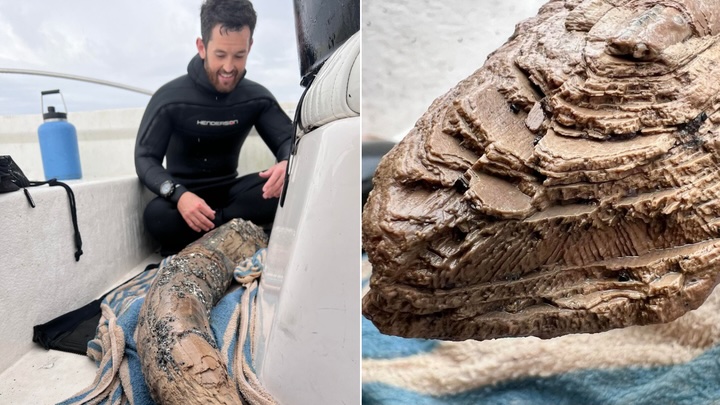
A diver in Florida recently made an incredible discovery while exploring the waters off the state’s coast.
Kyle Lundberg, who studied marine biology at the University of South Florida, was diving off Manasota Key, about 90 miles south of Tampa, when he stumbled upon an ancient mastodon tusk. He found this remarkable relic back in April while searching for fossils.
The tusk, which hasn’t been dated yet, could be millions of years old. Although he’s only 29 years old, Lundberg has been scuba diving for 12 years and has been hunting for fossils since he was “old enough to walk.”
“My dad would take us out to construction sites all the time to look for fossils as a kid,” Lundberg shared. He mentioned that while finding small pieces and chunks of tusk is common, discovering one as large and well-preserved as this is very rare. Tusks found in Florida are usually very delicate and often crumble apart.
According to the National Park Service (NPS), American mastodons went extinct around 10,500 years ago. Their fossils have been discovered across North America and Central America, from Alaska to Mexico. Despite what some people might think, mastodons are not the same as mammoths, though they are related and share a common ancestor with mammoths and elephants. Mastodons could grow as tall as 10 feet.
The NPS explains that while mastodons have been around since 4 to 3 million years ago, mammoths didn’t arrive in North America until much later, during the Pleistocene ice ages, which spanned from 2.6 million years ago to 11,700 years ago. Mastodons did live alongside mammoths in many areas, but all of these large creatures went extinct by about 10,500 years ago.
Lundberg has some advice for aspiring fossil hunters: remember to get a fossil permit. In Florida, these permits only cost five dollars each. “My best tip is to get out and explore and keep your head down,” he said. “This stuff is out there and all over the state.”
As for what will happen to the ancient mastodon tusk, Lundberg plans to keep it unless experts decide it is important enough to donate. “I plan on keeping it, but I do have to report it at the end of the year to the Florida Museum of Natural History,” he said. “If they deem it scientifically important, I have to donate it, but that is very unlikely.”
OMG
Daring Rescue: Duluth Firefighters Save Dog from Frigid Lake Superior

In a heart-pounding rescue mission on the shores of Duluth, Minnesota, a brave dog found himself in a perilous situation after leaping into the icy waters of Lake Superior. The daring rescue unfolded amidst eight-foot waves that crashed against the shore, creating a challenging environment for both man and canine.
The intense situation began when the adventurous dog managed to slip out of his leash, enticed by the allure of a chilly swim. Unbeknownst to the canine, Lake Superior’s vast expanse presented a danger he hadn’t anticipated. The situation quickly escalated, prompting the owner to dial emergency services.
To pinpoint the distressed dog’s location, dispatchers utilized cameras on a life bridge, offering a bird’s-eye view of the unfolding drama. The dog, buffeted by the relentless waves, struggled to stay afloat as firefighters donned specialized ice suits to brave the frigid waters.
These ice suits, designed for extreme cold-water rescues, provide a crucial barrier between the icy environment and the rescuers. Comprising layers of insulated materials, these suits not only keep firefighters warm but also offer buoyancy and protection against the harsh elements.
As the brave firefighters plunged into the turbulent waters, the dog faced the dual challenges of the waves and the numbing cold. Despite the difficult conditions, the rescue team, guided by the worried owner who remained on the shore, managed to locate the struggling canine.
The dog, large and frightened, repeatedly disappeared beneath the waves, making the rescue a daunting task. Through effective communication between the owner and the firefighters, the team successfully secured the dog by the collar, preventing him from slipping away.
Once the dog was safely in their grasp, both the firefighters and the canine were brought to safety aboard a waiting boat. The dog, now shivering and scared, received prompt medical attention. After warming up, the resilient pup even leaped happily into his owner’s car, a heartwarming conclusion to a potentially tragic event.
The Duluth Fire Department, often questioned about responding to animal-related emergencies, emphasized the significance of such actions in a Facebook post. They highlighted the deep bond between pets and their families, explaining that in their experience, if emergency responders did not intervene, well-meaning bystanders might take unnecessary risks.
The post also revealed a chilling detail: one of the dog’s owners had considered jumping into the treacherous waters. The fire department strongly discouraged such actions, emphasizing the importance of leaving water rescues to trained professionals equipped with the necessary gear.
“The Duluth Fire Department wants to stress to the public the importance of not putting yourself into a situation you are neither trained nor equipped to handle,” the post warned. “Given the wave and temperature conditions in the canal last night, anyone entering the water without the proper training and equipment would most likely have ended in tragedy.”
-

 OMG7 years ago
OMG7 years agoA Couple Gave Birth to the Most Beautiful Twins Ever
-

 OMG7 years ago
OMG7 years ago20 Rare Historical Photos
-

 OMG7 years ago
OMG7 years agoHilarious Airport Photos
-

 Cute7 years ago
Cute7 years agoMom Refuses to Let Daughter Eat Sugar and Years Later This is What She Grows Into
-

 OMG6 years ago
OMG6 years agoTop Secret Air Force One Facts That You Never Knew
-
OMG6 years ago
The Funniest Yearbook Photos Of All Time
-

 OMG7 years ago
OMG7 years agoRetired Mathematician Restores Log Cabin
-

 OMG5 years ago
OMG5 years agoWhat Happened When This ‘Duck Dynasty’ Legend Chopped Off His Beard?